Economics Assignment: Demand & Supply Laws Of Online Retailing Business
Question
Task:
Economics Assignment Task 1 (1500 words)
Demand and Supply analysis are fundamental to any business thus every business must understand its impact and dynamics. Demand and Supply analysis therefore underlines to some extent the growth and success of most businesses in our society today.
Critically analyze the following micro economics concepts with reference to any business of your choice.
1.1 Explain the law of Demand, movement along the same demand curve (with the aid of diagram) and changes in demand curve (with the aid of diagram).
1.2 Explain the law of Supply, movement along the same supply curve (with the aid of diagram) and changes in supply curve (with the aid of diagram).
Economics Assignment Task 2 (1000 words)
Compare and contrast emerging theories and models in 21st century contemporary economics with those of the 20th century, and relate both of these to modern business practices.
Answer
Introduction
The key purpose of the economics assignment is to provide a better understanding of the main principles of economics i.e. Demand and Supply. The chosen business for the assignment is ‘online retailing businesses’. The assignment will be divided into two parts that is task 1 and task 2. Under the first part of the assignment, there will an explanation of the demand and supply law, a discussion on the movement along the same demand and supply curve, which will be elaborated with the help of the diagram, and a discussion on the changes in their curve along with the help of a diagram. In the next section, there will be a comparison as well as the contrast between the contemporary economic theories and models of the 20th and 21st century.
Task 1
1.1. Law of Demand
One of the central theories that are included in economics is the law of demand that suggests that the consumers will demand a less quantity of a commodity if the price of the same is higher. As per demand law, value and the demand of a product are contrariwise connected to each other, however, other factors related to that good remain same. The relation of the price and demand can be described as the quantity demand of a commodity decreases when the price of that particular commodity rises and vice versa. As per the in-depth analysis, the demand law elaborates the behavior of consumer choice at the time of price alteration.
Therefore, online retail business is the highly demanded type of business by the public. In case of such business, since the other factors influencing demand remain unchanged in the market, the interrelation of the demand and price of a commodity refers to a natural consumer choice behavior. It occurs when a consumer pauses while spending an extra amount for the product with a fright of dealing with a shortage of cash (Economictimes.indiatimes.com, 2019). In this type of business, the law of demand works as per the consumer’s choice and their purchasing ability. Hence, when the price of the commodity rise, the quantity demanded for that product falls.
Movement along the same demand curve
In online business, such movement arises when all the factors remain constant and there is a variation in demand for a product because of the modification in quantity of a product demanded. This movement is shown along the demand curve in the diagram.
Upward movement of the demand curve- The curve of demand moves upwards once the price of a product rises and the quantity demanded decreases. It is also known as the contraction of demand.
Downward movement of the demand curve- The curve of demand moves downwards when the product price decreases and the demand for the same rises (AMADEO and BROCK, 2020).
Movement along the same demand curve
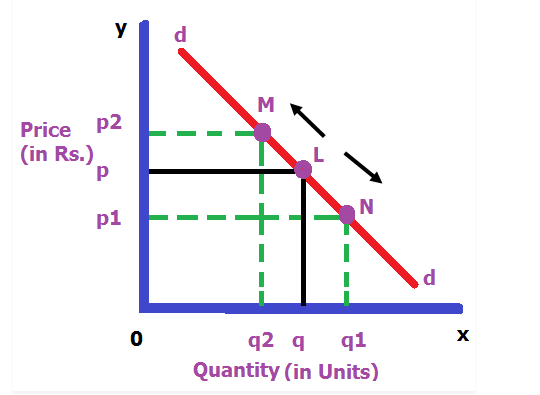
Figure 1: Movement in the same demand curve
Sources: (AMADEO and BROCK, 2020)
In the above-shown diagram, P designates the product price and Q designates the product quantity in the online retailing business. The increase in the price from OP to OP2 leads to a shift in the demand curve from OQ to OQ2 at point M. It is the reduction of the demand and indicates the rising movement of the curve of demand. Conversely, the decrease in the price of a product from OP to OP1 enables an increment of demand from OQ to OQ1, which is named the growth of demand. Therefore, it expresses the descending movement of the curve of demand.
Change in the demand curve
An alteration in the curve of demand occurs once there is a change in the factors of demand irrespective of the price. In the online retailing business, the change in demand curve takes place once the demand of a product varies even though the value is constant. Such a situation is considered to be uncommon as one of the five determinants such as income, customer trend, future price, substitute price, number of potential buyers changes irrespective of the price change.
Thus, if the consumer trend changes in the market, the consumer will prefer going with the trend and because of that, the demand for the previous products might fall. Therefore, the change in demand does not always occur just because of the price change but it also changes because of the other factors as well also when the value of the product do not change. Therefore, the factor causing the curve of demand to move is that the demand alters the quantity bought at each point of price. It means that when there is a rise in income, people will prefer buying more of every product. Therefore, the demand will increase with unchanged prices (Pettinger, 2019).
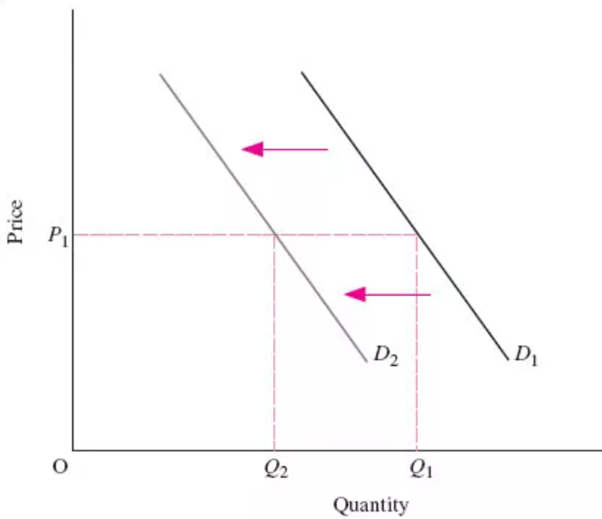
Figure 2: Change in the demand curve to left
Sources: (Pettinger, 2019)
The above diagram shows the change in the curve of demand leftwards in the online retailing business if the factors of the same causes demand to fall. In the diagram, the curve of demand has moved from D1 to D2 as indicated from the shift from Q1 to Q2, while the price remains constant. It indicates that the consumers of the retail business will purchase less quantity of products at every price level. It takes place throughout a recession when the income rate of people decreases. They will consume less of every product even if the price of that product remains unchanged (Pettinger, 2019).
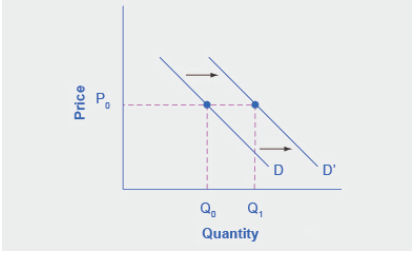
Figure 3: Shift in demand curve towards the right
Source: (Pettinger, 2019)
The demand curve moves towards right once the determinants enables the demand to increase. In the above-shown diagram, the demand curve of the online retail business is shifted from D to D1 when the price remains constant. It indicates that more of the goods and services are in demand at every price level. It indicates that a rise in the revenue will enable consumers to buy a larger amount of products moving the curve of demand towards the right (Pettinger, 2019).
1.2 Law of Supply
As per the economic fact, the law of supply is also considered as one of the major principles of economics. It defines that additional elements being unchanged, the cost and quantity supplied of a commodity are straight connected to each one another. It can also be defined as the supply of a commodity upsurge when the cost of the product paid by consumers, increases. Therefore, demand and supply are related to each as if the demand of a commodity rises, then the supply of the same product also rises and vice versa.
Therefore in case of online retailing business, the supply law observes the behaviour of producer while the price of the commodity alters. Graphically, the supply law indicates that the supply curve is upward sloping because suppliers hold the authority to select the number of their goods to be produced and brought to the market. In most cases, the supply of a commodity brought to the market remains the same and thus sellers decide to either sell or withhold their stock from a sale (Economictimes.indiatimes.com, 2019). The supply of online retailing business also works as per the consumer demand of a product. When the demand and price of the product increases, the suppliers to supply more of those products in the market and vice versa.
Movement along the same supply curve
In online retailing business, the movement of the supply curve occurs when the product price alters and other elements remain unchanged. It is due to the straight association amid cost and supply of a product. In simple words, it can be said that changes in the price of a product cause supply curves to expand or contract. However, when the product price rises, the supply of the same will also be increased while all other factors remain the same. This process is said to be the growth in the supply of a product. Realistically, this process will be shown as an upward movement along the same supply curve.
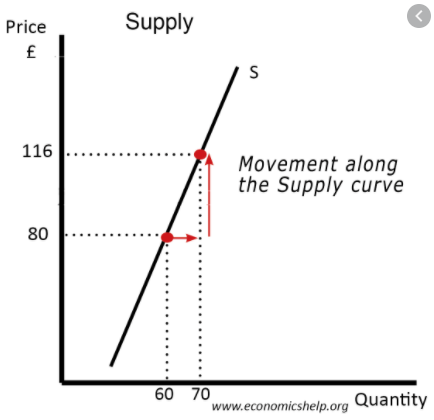
Figure 4: Movement in the supply curve
Source: (Mankiw, 2021)
With the consideration of the above diagram, it can be identified that as the price of a product rises in the online retailing business, the supply curve is moving in an upward direction. It shows that the rise in the prices in such business enables an upward-sloping supply curve. On the other hand, the supply curve falls downwards, when there is a decrease in the price level of a commodity. Therefore, it can be said that in online retailing business, the quantity of a product and the supply is interrelated to each other (Mankiw, 2021).
Changes in the supply curve
Changes in supply are derived from the economic term that suggests it takes place as soon as the suppliers of a provided product change manufacture or creation. Any alterations in the supply of a commodity in online retail business enable the supply to shift in the supply curve because of which market deals with the imbalances, which is corrected by the change in price and demand of that particular commodity. The change in the supply curve can be of two types such as rightward and leftward shift. The supply curve will shift towards the right when there is an increased alteration in supply and the supply curve will shift towards the left when there is a decreased change in supply.
In online retailing business, the change in the supply curve occurs in the form of new technologies consequences, such as extra effectual or fewer exclusive processes of manufacture or an alteration in the quantity of participants in the market.
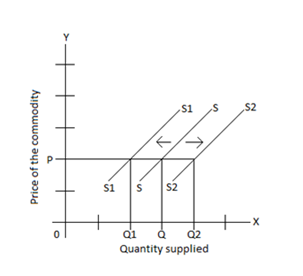
Figure 5: Change in the supply curve
Source: (Whelan and Msefer, 2021)
As per the above diagram, P denotes the product price whereas Q denotes the product quantity. Here, the price of a product remains constant but as the quantity of the product upsurges from Q to Q2, the supply curve has shifted towards the right i.e. from S to S2 and when the quantity reduces from Q to Q1, the supply curve shifted towards left i.e. from S to S1. It shows that when the quantity of the product increases in online retailing business, the supply also increases at the same time and vice versa (Whelan and Msefer, 2021).
Task 2
Theories and Models
Comparison
Theories of 20th-century contemporary economics
During the early 20th century, one of the best theories of economics was developed, namely, Neoclassical Economics, which was emerged in 1900 by William Stanley Jevons, Carl Menger, and Léon Walras with the motive of competing with the earlier theories of classical economics. Neoclassical economics refers to a broad theory that emphasizes supply and demand in the form of driving forces, behind the production, pricing, and consumption of commodities. The theory is designed as the classical economists realized that the most essential element in a price of a product is its production cost. The most effective observation of neoclassical economics is that as compared to the production cost the utility to consumers is the most essential factor in determining the value of the goods or services (Zuvekas, 2021).
Another major economic theory is Keynesian economics, which is referred to as the macroeconomic theory in economics and influences the output, employment, and inflation. This theory was established by John Maynard Keynes in 1930 with the motive of understanding the Great Depression. The main purpose of designing this theory is to focus on the variations in the economy over a short period of time. The initial motive of the theory was to abruptly distinct the learning of economic nature and markets depending upon the distinct inducements from the study of world economic collective variables and concepts (Weintraub, 2021).
Theories of 21st-century contemporary economics
As compared to the 20th-century economic theory, in the 21st century, economics have adopted many advanced theory and models as the world has changed into the more advanced universe. One of the modern theory of economics is Modern Monetary Theory (MMT) that refers to the heterodox macroeconomics framework, which states financially independent countries such as U.S, U.K, Japan, and Canada that expends, tax as well as uses in a authorised currency entirely regulated by them are not actively forced by incomes when it comes to federal government expenditure (Sumner, 2021).
As per the theory, the money is the public control and joblessness is indication that a money monopolist is excessively confining the financial assets supply, should pay taxes and meets savings desires. As per most of the researches, it has been identified that the theory of MMT indicates that they overestimate the relevance of fiscal policy. Also, the theorists of MMT are too indifferent to the restraints faced by the government that wishes to borrow money to finance spending.
The comparison of the theories indicates that modern theories have introduced more advancements in economics. The statements can be proved by the fact that the introduction of the theories in the 21st century has also treated employment as one of the most important growth determining factors in the economy. It m+eans that the modern theories encouraged the increment of employment that has helped the economic growth to a positive level. Hence, the growth of the economy in the 20th century was steady and less effective as compared to that of the 21st century (Farmer, 2010).
Contrast
From the above explanation, many differences between the theories of the 20th century and 21st century can be identified. It is because the economic growth and process with the theories and models of the 21st century are quite different. It is because there has been an addition of various new concepts, policies, technical factors, advancements that have changed the growth process of the economy. The last few decades have witnessed a huge change in the economic growth theory in this century. Some of the reasons behind the changes are the technological growth and other qualitative changes that lead to an increment of labor even if the elasticity of substitution between capital and labor might differ widely across sectors and specific production outlets. Another reason for the positive change due to the modern theory of economics is that the returns to scale are constant approximately. Therefore, the reasons indicate that the level of growth of GDP per working hour is identified by qualitative changes. The theory of the 21st century has mainly brought changes in productivity growth more than capital accumulation. It clearly indicates that there have been differences in the growth rate of GDP per capita. In addition to that this fact is appropriate with a description that focuses on a huge increment in the level of the duality of the world economy over most of the early 200 years, but is at variance with data for the last thirty to forty years. Therefore, these are the changes that have occurred with the help of the theories in the 21st century in economic growth. It has not only changed the way how the world economy grows but has also led the economy to reach a point where there is an advantage of most economic factors (Gomu?ka, 2021).
On the other hand, the theories of the 20th century were mainly focused on the foundation of the modern price theory, where the product markets and factor markets were carried out on a common methodological basis. In today’s economy, when the theories of the 20th century are used, most of the requirements are not met, whereas the theory of the 21st century can provide all the necessary solutions to the recent problems of the economy. It has also been identified that the early economic theory has improved the world economy and many greatest economists have developed many useful and effective policies that can also be used in today's economy. However, the growth rate was steady as compared to the recent growth (Mladenova, 2021).
Conclusion
The overall assignment is based on the economic factors and has highlighted the explanation of the law of demand and supply along with the movement of the demand and supply curve and their changes. As per the overall information, it has been clear that demand and supply are the most important factors and effective principles of economics and play a vital role in business. Both the elements are interrelated and work together. In addition to that, the assignment also has reflected upon the economic theories and models and has compared as well as contrasted the theories between the 21st century and 20th century.
References
AMADEO and BROCK, 2020. When Demand Changes But Price Remains the Price. [online] The Balance. Available at: https://www.thebalance.com/shift-in-demand-curve-when-price-doesn-t-matter-3305720#:~:text=When%20the%20demand%20curve%20shifts.
Economictimes.indiatimes.com, 2019. What is Law Of Demand? Definition of Law Of Demand, Law Of Demand Meaning - The Economic Times. [online] The Economic Times. Available at: https://economictimes.indiatimes.com/definition/law-of-demand.
Economictimes.indiatimes.com, 2019. What is Law Of Supply? Definition of Law Of Supply, Law Of Supply Meaning - The Economic Times. [online] The Economic Times. Available at: https://economictimes.indiatimes.com/definition/law-of-supply.
Farmer, R. (2010). Macroeconomics for the 21st century: Part 1, Theory. [online] VoxEU.org. Available at: https://voxeu.org/article/macroeconomics-21st-century-part-1-theory.
Gomu?ka, 2021. [online] Available at:
Mankiw, 2021. [online] Csun.edu. Available at:
Mladenova, 2021. [online] Available at:
Pettinger, T., 2019. Shift in Demand and Movement along Demand Curve. [online] Economics Help. Available at: https://www.economicshelp.org/blog/581/economics/changes-in-demand/.
Sumner, 2021. Understanding Modern Monetary Theory: Part 1 - Econlib. [online] Econlib. Available at:
Weintraub, 2021. Neoclassical Economics, by E. Roy Weintraub: The Concise Encyclopedia of Economics | Library of Economics and Liberty. [online] Econlib.org. Available at:
Whelan and Msefer, 2021. [online] Ocw.mit.edu. Available at:
Zuvekas, 2021. Economic Theory - an overview | ScienceDirect Topics. [online] Sciencedirect.com. Available at:












